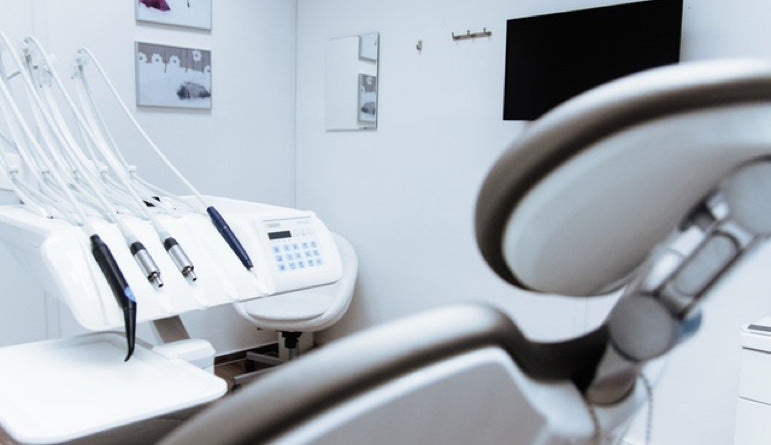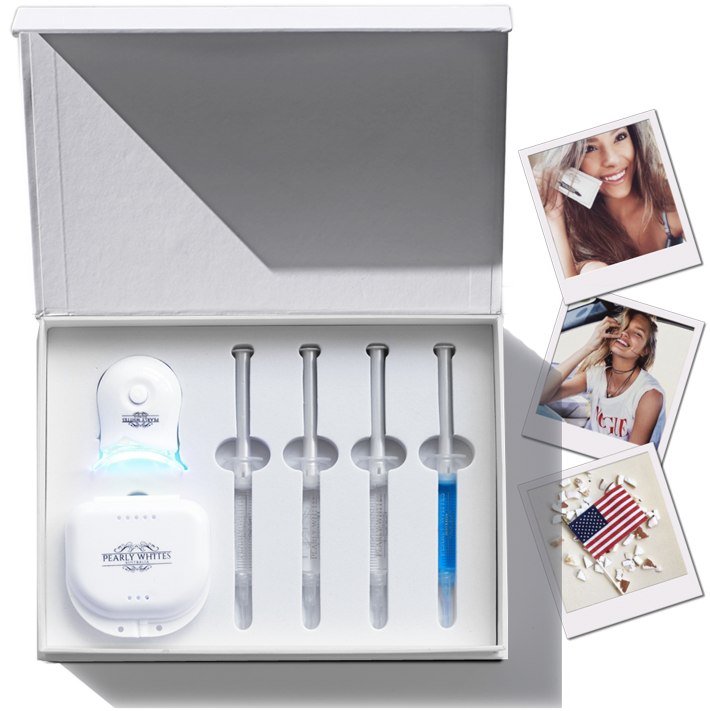Teeth Whitening
 Over the last two decades, teeth whitening has become the most popular cosmetic dentistry procedure, offered by many dental professionals. It is a fast, economical and safe way to dramatically improve your smile. There are a number of different approaches, including in-office whitening procedures, at-home teeth whitening kits, teeth whitening strips and a variety of home remedies that vary in their effectiveness.
Over the last two decades, teeth whitening has become the most popular cosmetic dentistry procedure, offered by many dental professionals. It is a fast, economical and safe way to dramatically improve your smile. There are a number of different approaches, including in-office whitening procedures, at-home teeth whitening kits, teeth whitening strips and a variety of home remedies that vary in their effectiveness.
How Does Teeth Whitening Work?
 Most teeth whitening treatments contain chemicals called peroxides (either hydrogen peroxide or carbamide peroxide). These bleaches break down the stubborn tooth stains on your enamel (the white, outer part of the tooth), making the tooth stains less concentrated and the discoloration less noticeable.
Most teeth whitening treatments contain chemicals called peroxides (either hydrogen peroxide or carbamide peroxide). These bleaches break down the stubborn tooth stains on your enamel (the white, outer part of the tooth), making the tooth stains less concentrated and the discoloration less noticeable.
There are a number of factors that cause teeth to become discolored. Some of these are simply a part of life such as teeth yellowing due to our genetics or age, while others are due to lifestyle choices such as poor dental hygiene, smoking, coffee and red wine. Even certain medications and medical treatments like chemotherapy can cause our teeth to darken.
Good oral care, including regular brushing and flossing your teeth, will help to remove the surface stains, lighting your teeth by approximately one shade. But even toothpastes containing polishing agents can’t remove the color deep in the tooth enamel, and that’s where professional teeth whitening options come in.
How Much Does it Cost to Get Your Teeth Whitened at the Dentist?

Teeth whitening at the dentist’s office, also called in-office bleaching or chairside bleaching, costs around $650 per treatment with laser teeth whitening at a dental clinic costing in the region of $1000+ per visit. In-office teeth whitening procedures are not typically covered by dental insurance programs so be sure to check with your insurer.
Dentist dispensed kits are considerably cheaper than in-chair bleaching procedures, costing an average of $400 while over the counter (OTC) kits cost $100 to $200.
How Effective are At-Home Teeth Whitening Kits?
Home whitening kits can be very effective if used correctly. With regular use you should see your teeth become up to three or four shades lighter. The greatest results will be seen by those with more discoloration, but even if you have white teeth to begin with you should still notice a brighter smile as a result of using a home whitening system.
There are two types of home whitening kits, the ones you get from your dentist and over the counter (OTC) dental bleaching kits. Both use trays that you fill with a small amount of whitening gel that you then place snuggly over your teeth. How well the kit works to whiten your teeth depends on:
- how stained your teeth are to begin with and the cause of the discoloration;
- the strength of the whitening gel (the percentage of HP / CP);
- how carefully you follow the instructions;
- your oral care routines and lifestyle.
Whether you use a dentist dispensed or OTC kit it’s essential to follow the instructions closely.
Teeth Whitening at Home vs at the Dentist
Both in-chair and home treatments work well, which one you choose is dependent on your budget, time, how fast you want results and how much whiter you want your teeth to be.
Teeth Whitening at Home |
Teeth Whitening at the Dentist |
|
| Cost |
Affordable $100 to $200 for professional quality OTC whitening trays with enough gel for up to 12 months. Not typically covered by insurance. |
Expensive $500 to $1000 for each chairside bleaching treatment although you can find special offers. Not typically covered by insurance. |
| Convenience |
Very convenient Whiten when and where you want. You can do simple household tasks, read or watch TV while the trays are in. |
Less convenient Requires appointments of roughly an hour each time. |
| Speed |
Less Fast Generally requires several applications (check your kit for specific instructions) |
Fast One treatment of up to an hour each year. |
| Results |
Up to four shades lighter Home whitening uses bleaching agents with 3%-15% hydrogen peroxide and so it’s a great choice if you have mild to moderate discoloration, or you are willing to do several whitening sessions. |
Up to eight shades lighter In-chair whitening uses bleaching agents with 15%-43% hydrogen peroxide and so it’s a good option for those with more seriously stained teeth . |
Buy a Pearly Whites At-home Teeth whitening kit online for $ 99.95 $ 59.95, that's $ 40 off.

What is the Best Whitener for Your Teeth?
The tooth whitener that will work best for you depends on why your teeth are discolored, how fast you want results, your budget and your schedule.
Cause of discoloration: The common reasons for teeth turning yellow are age, food/drink staining and smoking. These are all good candidates for teeth whitening treatments. It’s important to note that not all tooth staining can be treated with dental bleaching. Some causes of discoloration, such as trauma, medications, medical treatments, disease or dental work may require a different solution like dental veneers.
Speed of results: Chairside treatments are definitely the fastest dental whitening method as the product that’s used has a higher percentage of HP/CP than home use products are allowed to have.
Cost: In-chair treatments will set you back anywhere from $500 to $1000 depending on the type of treatment and where you have it done. By comparison, take home trays from the dentist cost around $400 while over the counter whitening trays are priced from $100.
Convenience: If your schedule allows you to make and keep dental bleaching appointments then in-chair treatments are a good option. Those with hectic schedules who can’t afford the hour long visit to the dentist (plus travel time) might prefer the ability to whiten in their home at a time that’s convenient for them, while still being able to do other things.
How Can I Whiten My Teeth Quickly?
The quickest way to whiten teeth is usually with an in-chair treatment at the dentist as dental clinics are allowed to use high strength HP and CP. In-chair bleaching is considerably more expensive than take home whitening trays but it has the benefit of providing fast results. The flip side is that chairside bleaching may be too strong for some people’s teeth and cause sensitivity. If in-chair dental bleaching isn’t an option for you, a good alternative is to use a reputable home whitening product. Though they take slightly longer than chairside treatments they are more affordable and, if used correctly, are less likely to cause sensitivity for some people.
How Does a Dentist Whiten Teeth?
All teeth whitening works by applying tooth-safe bleach (hydrogen peroxide or carbamide peroxide) to the teeth. This bleaches out the discoloration and stains on the enamel returning your teeth to a lighter shade, giving you smile makeover.
On the day of your appointment, your dentist will most likely start by giving you a prophylactic cleaning and dental exam followed by photos to chart the whitening progress. Next is the insertion of a cheek retractor in order to expose the teeth that are visible when you smile (esthetic zone teeth). The gums are protected and finally the bleaching gel is applied and left for up to 30 minutes (the exact amount of time depends on the dentist, treatment, level of staining and health of your teeth). A specialized light (laser/ultra violet/LED) may or may not be used, depending on the type of treatment.
Once the correct amount of time has elapsed the gel is washed or suctioned off and the teeth are checked. If the hoped for results have not yet been reached, the bleaching gel is once again applied for up to 30 minutes. After the second application of gel is removed and the teeth once again checked, a third application may be done. Once the final application of gel is removed the cheek retractors will be taken out and the new tooth shade compared with the way they looked before the treatment began.
You can expect to see a result of anywhere from three to eight shades but the true color won’t actually show until a few days after the treatment. Use a shade guide to track your results.
You may also be offered take home whitening trays to try to achieve a better result or for ongoing maintenance.
How Can I Get Rid of Yellow Teeth?
Teeth whitening procedures and products have been shown to be very effective in bleaching yellow teeth several shades whiter. Both in-chair and over-the-counter bleaching products actually work best on teeth that look yellow. Teeth develop a yellowish tint during the natural process of aging as well as from stains caused by foods and beverages. This discoloration can be difficult, if not impossible, to remove just by brushing your teeth, even with whitening toothpastes. A dental bleaching treatment can help to restore your smile.
Does Whitening Work on All Teeth?

Teeth whitening works well for:
- Extrinsic stains – Extrinsic stains are on the enamel (the outer layer of the tooth) and are usually caused by organic material such as food, drinks and smoking. Whitening treatments are very effective at removing extrinsic tooth stains.
- Aging teeth - Tooth bleaching is also effective on the yellowing of the teeth that naturally occurs with age.
Teeth whitening does not work well for:
- Intrinsic stains – Intrinsic stains are when the dentin (the inner structure of the tooth) darkens or becomes yellow. These types of stains do not typically respond well to teeth bleaching, although whitening may have some effect. Intrinsic discoloration can be caused by poor dental care resulting in tooth decay, fluorosis, dentinogenesis imperfecta, trauma or tetracycline antibiotics.
- Genetic tooth discolorations - Some people have genetic factors that affect the color of their teeth. If your inherited genes have given your teeth a yellow, brown or gray hue teeth whitening is unlikely to have a noticeable effect.
- Dental work – dental restorations such as fillings, caps, dental crowns, veneers, retainers or dental implants won’t change color during teeth whitening. Any teeth not covered with dental work will whiten but the dental work will no longer match your teeth and may need to be replaced.
Additionally there are some people who, for various reasons, are not good candidates for dental bleaching. These include people with excessively sensitive teeth, pregnant and breastfeeding mothers, children under the age of 18, anyone who’s recently had oral surgery, has exposed roots or dentine, periodontal disease or jaw problems.
How Effective are Teeth Whitening Toothpastes
 Whitening toothpastes do not have the active ingredients that in-chair or OTC teeth whitening kits do and so will not produce the same level of results. If you already have fairly white teeth and you just want to keep them that way whitening toothpastes may be all you need. They are also useful for maintaining your results between whitening treatments, especially if you smoke or frequently eat or drink things that cause staining.
Whitening toothpastes do not have the active ingredients that in-chair or OTC teeth whitening kits do and so will not produce the same level of results. If you already have fairly white teeth and you just want to keep them that way whitening toothpastes may be all you need. They are also useful for maintaining your results between whitening treatments, especially if you smoke or frequently eat or drink things that cause staining.
Most toothpaste, even the ones not labeled “whitening”, have mild abrasives that removes stains on your teeth. Whitening toothpastes also have polishing agents that make the stain removal more effective. What they don’t do is change the actual color of the teeth. This is because whitening toothpastes only contain up to 1% hydrogen peroxide and many don’t contain any HP or CP at all.
How Long Does Teeth Whitening Last?
 The results from in chair bleaching can last for six months to a year. Results from dentist dispensed whitening trays may be similar. OTC kits do not contain the high levels of bleach that dentists are allowed to use and so maintenance will need to be more frequent.
The results from in chair bleaching can last for six months to a year. Results from dentist dispensed whitening trays may be similar. OTC kits do not contain the high levels of bleach that dentists are allowed to use and so maintenance will need to be more frequent.
No matter what teeth whitening solution you use, how long the results last will largely depend on what type of tooth stains you have. If you have extrinsic stains (on the surface of the tooth) your results will be longer lasting. If your stains are intrinsic (deep stains underneath the enamel) you are unlikely to see significant results.
Other things that effect your results are your overall health and lifestyle. Before you begin whitening of any sort it’s a good idea to get a scale and clean. After whitening avoid smoking and foods and drinks that cause staining. This will help you to maintain your results for longer.
In order to keep your teeth white for as long as possible after bleaching:
- make an appointment for dental cleaning and scaling before you start whitening;
- avoid foods and drinks that cause staining;
- don’t smoke;
- rinse your mouth immediately after eating and drinking;
- have good oral hygiene to improve your overall dental health.
Is it Safe to Whiten Teeth?
Both in-office bleaching and at home teeth whitening methods are safe and effective when done correctly. It is essential that you closely follow the instructions from your dentist or on the whitening kit. Failure to do so can result in sore gums and tooth sensitivity. Don’t try to whiten for longer, or use more gel, than is recommended. It won’t speed up the process and you may cause yourself discomfort or even damage your tooth enamel or soft tissues of the mouth.
Teeth whiteners are not drugs and so are not subject to FDA regulation. The American Dental Association (ADA) runs a limited, voluntary Seal of Acceptance program for toothpastes and some dentist dispensed tooth bleaching products, but the expense is born by the manufacturer and so not everyone applies. Participation is also currently limited to tooth bleaching products of certain strengths and does not include any laser treatments at all.
Are There Any Side Effects from Teeth Whitening?
Some people who use teeth whiteners may experience tooth sensitivity. This happens when the peroxide in the whitening formula gets through the enamel to the soft layer of dentin and irritates the nerve of your tooth. The sensitivity is usually mild and only temporary. If you already had sensitive teeth before you began whitening be sure to use sensitive toothpaste during the whitening process. The potassium nitrate in the toothpaste will help soothe the nerve endings of your teeth and prevent any additional sensitivity.
The other common side effect of teeth whitening is mild irritation of the gums and soft tissues of the mouth due to ill fitting or over filled trays. This results in the peroxide gel seeping out onto the gums and causing discomfort, or in the tray itself irritating the soft tissues. Use less gel, make sure the trays fit snugly on your teeth and that no gel seeps out onto your gums.
If you do experience any ill effects shorten the length of time you whiten or stop whitening until things return to normal. If you’re undergoing in-chair treatments talk to your dentist about any issues before your next procedure. If you’re using a dental bleaching kit, be especially careful to follow the directions.

TOP TIP: If you have sensitive teeth we recommend a kit that comes with a desensitization gel, such as the one included in the Pearly Whites Professional Teeth Whitening Kit. Alternatively, Pearly Whites also offers Coconut and Charcoal Whitening Strips, which are specially formulated for people with sensitive teeth.
